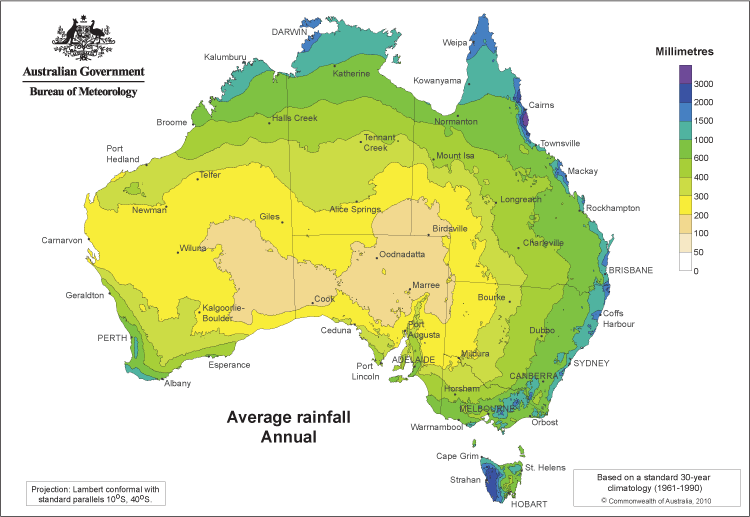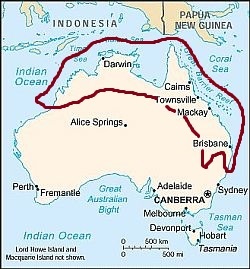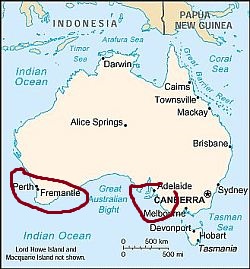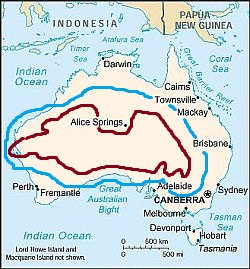Which part or Australia typically receives the most moisture?
1 Answer
The part of Australia with the most precipitation is the Tropical Climate area in the north
Explanation:
Rainfall in Australia tends to decrease as you move from north to south, and as you move from the east coast to the interior.
So the areas of high rainfall tend to generally occur in a curve from the north of the continent, then around to the east side, then down to the south.
Here is a color-coded map that shows the average yearly precipitation in Australia:

http://www.eldoradocountyweather.com/forecast/australia/australia-yearly-rainfall.html
According to the web site "Climates to Travel,"
https://www.climatestotravel.com/climate/australia
the precipitation of Australia can be conveniently divided into four large regions:
-
Tropical climate (Darwin, Brisbane) --The rainiest area
-
Mediterranean climate (Perth, Adelaide)
- Arid climate
- South-east (Canberra, Sydney, Melbourne, Hobart)
#color(white)(mmmmmmmm)# _____
1. The Tropical Climate area
The vast northern area has a tropical climate, with a dry and sunny season ("the dry"), usually from May to October, and a rainy and muggy season ("the wet"), usually from November to April.
The annual rainfall exceeds 15.5" and is more abundant along the northernmost and the eastern coasts, where it exceeds 47".
The tropical rains occur mainly in the afternoon or evening in the form of downpours or thunderstorms. In the south-east, where Brisbane is located, the winter is cooler, so the climate becomes sub-tropical. Vegetation is savanna-type in the driest areas, with rainforests in the wettest part of the north-eastern coast.
In Darwin, the capital of the Northern Territory, 58.5" of rain per year fall, mostly between November to early April. The rainiest month is January, with almost 15.5" of rain. But from May to September it almost never rains.
Here is the average precipitation in inches for Darwin:
Jan|Feb|Mar|Apr|May|Jun|Jul|Aug|Sep|Oct|Nov|Dec| YEAR
———————————————————————————
15 | 12 | 10 | 4 | tr | tr | 0 | 0 | tr | 2 | 5 | 10 | 58.5
Here is a map of the Tropical Climate area

https://www.climatestotravel.com/climate/australia#tropical
2. The Mediterranean Climate
There are a couple of areas with a Mediterranean climate, with mild and rainy winters, and warm and sunny summers.
In Perth, Western Australia, 31.5" of rain falls in a typical year, most of which occurs from May to August, with a maximum of 6.7" in July, the central month of winter.
Here's a map of the Mediterranean climate areas of Australia:

https://www.climatestotravel.com/climate/australia#tropical
3. The Arid Climate
In the vast area called "the Outback," the climate is arid semi-desert (with annual precipitation between 8 and 16" per year), or even desert (below 8" per year.)
In the semi-desert area, the rains in the north-central part fall in the form of downpours or thunderstorms in the hottest period, while in the southernmost part they occur mostly in winter.
In the most arid area, the rains are rare and sporadic, but every now and then a thunderstorm may erupt, most likely in summer.
Here is a map of the Arid Climate area

https://www.climatestotravel.com/climate/australia#tropical
You can find out more about Australia's climate here:
http://www.abs.gov.au/ausstats/abs@.nsf/Lookup/by%20Subject/1301.0~2012~Main%20Features~Australia%27s%20climate~143

